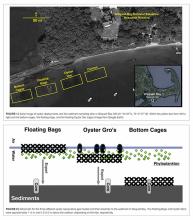
Abstract
Coastal ecosystems are impacted by excessive nutrient inputs that cause degradation of water quality and impairments of ecosystem functioning. Regulatory and management efforts to enhance nutrient export from coastal ecosystems include sustainable oyster aquaculture that removes nitrogen in the form of oyster biomass and increases particulate export to underlying sediments where increased organic material may enhance microbial denitrification. To better understand the impacts of oyster aquaculture on nitrogen removal, we examined bacterial processes in sediments underlying three of the most common aquaculture methods that vary in the proximity of oysters to the sediments. Sediment samples underlying sites managed with these different aquaculture methods were examined using the 16S rRNA gene to assess microbial community structure, gene expression analyses to examine nitrogen and sulfur cycling genes, and nitrogen gas flux measurements. All sites were located in the same hydrodynamic setting within Waquoit Bay, MA during 2018 and 2019. Although sediments under the different oyster farming practices showed similar communities, ordination analysis revealed discrete community groups formed along the sampling season. Measured N2 fluxes and expression of key genes involved in denitrification, anaerobic ammonium oxidation (anammox), and dissimilatory nitrate reduction to ammonium (DNRA) increased during mid-summer and into fall in both years primarily under bottom cages. While all three oyster growing methods enhanced nitrogen removal relative to the control site, gene expression data indicate that the nitrogen retaining process of DNRA is particularly enhanced after end of July under bottom cages, and to a lesser extent, under suspended and floating bags. The choice of gear can also potentially increase processes that induce nitrogen retention in the form of ammonia in the underlying sediments over time, thus causing deviations from predicted nitrogen removal. If nitrogen removal is a primary objective, monitoring for these shifts is essential for making decisions about siting and size of aquaculture sites from year to year.
About this article
This open access article, published in Frontiers in Marine Science in 2021, describes work done as part of a 2017-2020 collaborative research project conducted at Waquoit Bay Reserve in Massachusetts. The article explores the impacts of oyster aquaculture on nitrogen removal by examining bacterial processes in sediments underlying three of the most common aquaculture methods that vary in the proximity of oysters to the sediments.
Mara, P., Edgcomb, V.P., Sehein, T.R., Beaudoin, D., Martinsen, C., Lovely, C., Belcher, B., Cox, R., Curran, M., Farnan, C., Giannini, P., Lott, S., Paquette, K., Pinckney, A., Schafer, N., Surgeon-Rogers, T.-M., Rogers, D.R., 2021. Comparison of Oyster Aquaculture Methods and Their Potential to Enhance Microbial Nitrogen Removal From Coastal Ecosystems. Frontiers in Marine Science 8.633314. https://doi.org/10.3389/fmars.2021.633314